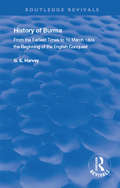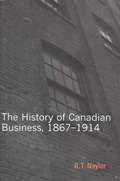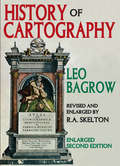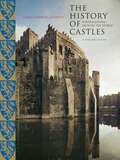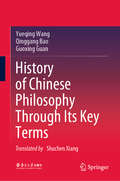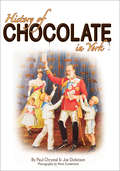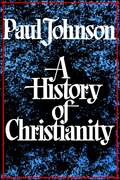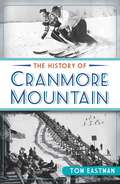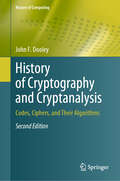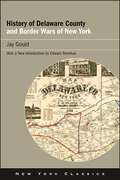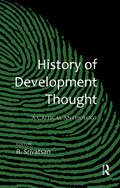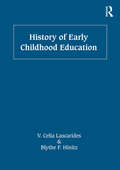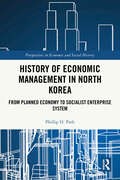- Table View
- List View
History of Britain and Ireland: The Definitive Visual Guide (DK Definitive Visual Histories)
by DKDiscover the pivotal political, military, and cultural events that shaped British and Irish history, from Stone Age Britain to the present day, in this revised and updated ebook.Combining over 700 photographs, maps, and artworks with accessible text, the History of Britain and Ireland is an invaluable resource for families, students, and anyone seeking to learn more about the fascinating story of the England, Scotland, Wales, and Ireland. Spanning six distinct periods of British and Irish history, this ebook is the best way to find out how Britain transformed with the Norman rule, fought two world wars in the 20th century, and faced new economic challenges in the 21st century.DK's visual guide places key figures - from Alfred the Great to Winston Churchill - and major events - from Roman invasion to the Battle of Britain - in their wider context, making it easier than ever before to learn how they influenced Britain and Ireland's development through the age of empire into the modern era.
History of Britain and Ireland: The Definitive Visual Guide, New Edition (DK Definitive Visual Histories)
by DKFrom ancient bloody battles and colonial conquests to the Industrial Revolution and Beatlemania, this visual guide leads you through major moments in British and Irish history.Discover the pivotal political, military, and cultural events that shaped British and Irish history, from the Stone Age to the present day. Combining over 700 photographs, maps, and illustrations with accessible text, History of Britain and Ireland is an invaluable resource for anyone seeking to learn more about the British Isles. Spanning six distinct periods of English, Welsh, Scottish, and Irish history, the book tells you how Britain transformed with Norman rule, fought two World Wars in the 20th century, and finally came to terms with a new status in a fast-changing economy.This comprehensive volume places key figures – from Alfred the Great to Winston Churchill – and major events – from Caesar's invasion to the Battle of the Somme – in their wider context. This makes it easier than ever before to learn how certain charismatic leaders, political factions, and specific events influenced Britain and Ireland's development through the Age of Empires and into the modern era.Beautifully illustrated, History of Britain and Ireland is sure to delight history buffs of all ages.
History of British European Airways, 1946–1972: 1946 - 1972
by Charles WoodleyBEA was formed in 1946 and took over most UK domestic and European routes under the British government's nationalisation policy. It began operations with a fleet of outdated and hopelessly uneconomic passenger aircraft that were derivatives of wartime types such as the DC-3, Avro Viking and Rapide. By the end of 1955 the airline had re-equipped with more modern types such as the jet-prop Viscount and moved into a profit for the first time. From 1960 onwards the airline introduced larger jets such as the Comet, Trident and BAC 1-11. BEA merged with the British Overseas Airways Corporation in 1974 to form British Airways.This book looks at BEA's predecessors, its formation and early operation from Croydon and Northolt and the move to the newly-opened London Heathrow. The evolving structure is explained with chapters covering engineering bases, terminals, European and domestic services, cargo services and helicopter operations. The aircraft flown are all described in detail and the book includes anecdotes from former crew and ground-staff, a full fleet list and is highly illustrated throughout.
History of British Film (Volume 4): The History of the British Film 1918 - 1929
by Rachael LowThis set is one of the cornerstones of film scholarship, and one of the most important works on twentieth century British culture. Published between 1948 and 1985, the volumes document all aspects of film making in Britain from its origins in 1896 to 1939.Rachael Low pioneered the interpretation of films in their context, arguing that to understand films it was necessary to establish their context. Her seven volumes are an object lesson in meticulous research, lucid analysis and accessible style, and have become the benchmark in film history.
History of Burma: From the Earliest Times to 10 March 1824 The Beginning of the English Conquest (Routledge Revivals)
by G. E. HarveyOriginally published in 1983, this book explores the history of Burma, including chapters on Burma before 1044, The Kingdom of Pagan and the Shan Dominion. Burma's history had been little studied until recently, until the Burma Research Socety, founded in 1910, began to collect material of all kinds, and this book may be regarded therefore as one of the first-fruits. The book presents a mass of original work and incorporates the results of research up to the date of going to press; it offers a flood of light on the still many dark places of Burmese history and constitutes distinctly a step forward in our knowledge of the subject.
History of Canadian Business
by R. T. NaylorAn unprecedented work in Canadian historiography, The History of Canadian Business, 1867-1914 has been chosen by the Social Sciences Federation of Canada as one of the twenty most outstanding works in the field in the last half of the twentieth century.
History of Canadian Business: The Banks And Finance Capital (Carleton Library Series #207)
by R.T. NaylorAn unprecedented work in Canadian historiography, The History of Canadian Business, 1867-1914 has been chosen by the Social Sciences Federation of Canada as one of the twenty most outstanding works in the field in the last half of the twentieth century.
History of Cartography: Enlarged Second Edition
by Leo BagrowThis illustrated work is intended to acquaint readers with the early maps produced in both Europe and the rest of the world, and to tell us something of their development, their makers and printers, their varieties and characteristics. The authors' chief concern is with the appearance of maps: they exclude any examination of their content, or of scientific methods of mapmaking. This book ends in the second half of the eighteenth century, when craftsmanship was superseded by specialized science and the machine. As a history of the evolution of the early map, it is a stunning work of art and science.This expanded second edition of Bagrow and Skelton's History of Cartography marks the reappearance of this seminal work after a hiatus of nearly a half century. As a reprint project undertaken many years after the book last appeared, finding suitable materials to work from proved to be no easy task. Because of the wealth of monochrome and color plates, the book could only be properly reproduced using the original materials. Ultimately the authors were able to obtain materials from the original printer Scotchprints or contact films made directly from original plates, thus allowing the work to preserve the beauty and clarity of the illustrations.Old maps, collated with other materials, help us to elucidate the course of human history. It was not until the eighteenth century, however, that maps were gradually stripped of their artistic decoration and transformed into plain, specialist sources of information based upon measurement. Maps are objects of historical, artistic, and cultural significance, and thus collecting them seems to need no justification, simply enjoyment.
History of Castles, New and Revised
by Christopher GravettThe History of Castles is the ultimate guide to the world&’s most fascinating castles and strongholds. Chapters include information on castles from France, England, Wales, Scotland, Ireland, Germany, Austria, Switzerland, the Iberian Peninsula, Italy, Scandinavia, Eastern Europe, Russia, and the Middle East. An ideal book for history enthusiasts, people planning to take a vacation near one of these castles, and for anyone who is enamored of these breathtaking buildings.
History of Chinese Folk Literature (Understanding China)
by Zhenduo ZhengThis book mainly addresses the position, function, influence, and values of folk oral literature in the history of Chinese literature. Divided into 14 chapters, it systematically covers central aspects of folklore literature such as ballads, folk songs, Bianwen, Zajuci, Guzici, Zhugongdiao, Sanqu, Baojuan, Tanci, Zidishu, and so on from the Pre-Qin to the late Qing Dynasties, filling several gaps in literary history studies. It is a comprehensive literary work, and many of the materials cited here are rare and difficult to find. In addition, the book proposes some important theories, especially six highly generalized qualities of folk literature, namely that it is: popular, collective, oral, fresh, effusive, and innovative.With detailed, extensive materials, and quotations, the book represents the most systematic and comprehensive work to date on ancient Chinese folk literature. It is mutually complementary with Guowei Wang’s A Textual Research of the Traditional Chinese Opera in the Song and Yuan Dynasties and Xun Lu’s A Brief History of Chinese Fiction; all three works are regarded as the most essential classics for researching the history of Chinese literature.
History of Chinese Imperial Examination
by Liu Haifeng Li BingThis book is a comprehensive and systematic exposition of the history of the emergence, development, and evolution of Chinese imperial examination system. It gathers the author’s insights from over thirty years of research on the history of the imperial examination and can be regarded as a summary work on the study of imperial examination history in China. It follows the historical sequence, taking the development and evolution of the imperial examination as the warp, and the characters, events, activities, and thoughts as the latitude. It not only narrates the history of the imperial examination system, but also pays attention to the actual operation of the imperial examination system. At the same time, it takes into account the historical development of examination thought. And during narration, it focuses on the interaction and interdependence between people and the system, as well as their interactive influence. Therefore, it is both academic and readable.
History of Chinese Philosophy Through Its Key Terms
by Yueqing Wang Qinggang Bao Guoxing GuanThis book provides a conceptual overview of the evolution of Chinese philosophy from its earliest beginnings to the end of the imperial era, highlighting 38 of the most essential terms in the Chinese philosophical tradition. Written by prominent contemporary scholars from Mainland China, the respective chapters cover topics ranging from cosmology, benti metaphysics, human nature, self-cultivation, and methodology, to views on history and politics. Each chapter addresses one of the constitutive terms of the Chinese philosophical tradition and provides clear historical information on how it was used and developed during the key periods of Chinese philosophy.Highlighting both central concepts and essential structures of Chinese philosophy, the book allows readers to view the history of Chinese philosophy from the perspective of the Chinese themselves. Offering content that is both academically rigorous and accessible for a wider audience, this book is an indispensable reference guide for all students of Chinese philosophy.
History of Chinese Philosophy in the Ming Dynasty
by Xuezhi ZhangThis book starts with the classification of the main views of different thinkers after the study of the original materials, which covers all the thinkers’ thoughts and conceptions. A major objective of this book is to reveal the ideas of the philosophers. Key ideological opinions are stated with the former discussion of exact questions and further clarification of their philosophical meaning, which enables the readers to better understand the meaning and value of the philosophical thoughts. Since the logic and history are in accordance with each other, a frame of conception is formed then. Then, the author clearly explains the logical relationship in the frame mentioned before, as well as the formation of the key concepts and their relationship.
History of Chocolate in York
by Paul Chrystal Joe DickinsonA deliciously illustrated historical tour of England&’s &“chocolate city.&” In the nineteenth century, York was renowned for confectionery—particularly chocolate. Treats like Kit Kat, Fruit Gums, All Gold, and Butterkist were made by York companies Rowntree&’s, Terry&’s, and M.A. Craven and Son. This new book is the first to chart the history of chocolate and confectionery manufacture and marketing by York companies, from their origins in the eighteenth century through to recent takeovers by Nestle, Tangerine, and Kraft. Revolutionary new products such as Easter eggs in the 1870s and chocolate assortments in the 1890s are covered—along with such crucial turn-of-the-century developments as milk chocolate and the chocolate bar. The significance to the industry of the Quaker movement is discussed, along with an examination of the impact of the world wars and the intervening depression. Fully illustrated throughout, this book provides both an enlightening view of the chocolate industry—from production, quality control, distribution, and marketing to packaging, design, and branding—as well a tasty morsel of British history.
History of Christianity (Pelican Ser.)
by Paul JohnsonFirst published in 1976, Paul Johnson&’s exceptional study of Christianity has been loved and widely hailed for its intensive research, writing, and magnitude—&“a tour de force, one of the most ambitious surveys of the history of Christianity ever attempted and perhaps the most radical&” (New York Review of Books).In a highly readable companion to books on faith and history, the scholar and author Johnson has illuminated the Christian world and its fascinating history in a way that no other has. Johnson takes off in the year AD 49 with his namesake the apostle Paul. Thus beginning an ambitious quest to paint the centuries since the founding of a little-known &‘Jesus Sect&’, A History of Christianity explores to a great degree the evolution of the Western world. With an unbiased and overall optimistic tone, Johnson traces the fantastic scope of the consequent sects of Christianity and the people who followed them. Information drawn from extensive and varied sources from around the world makes this history as credible as it is reliable. Invaluable understanding of the framework of modern Christianity—and its trials and tribulations throughout history—has never before been contained in such a captivating work.
History of Cranmore Mountain, The
by Tom EastmanIn 1938, developer Harvey D. Gibson rented a rope tow from ski shop founder Carroll P. Reed and moved it to Cranmore Mountain. This was the humble beginnings of what would become a booming ski industry in North Conway, New Hampshire. Snow trains of the 1930s would transport skiers and snowsport enthusiasts to this idyllic winter playground nestled in the White Mountains. Cranmore has been home to numerous ski legends, including Austrian ski great Hannes Schneider, renowned as the "Father of Modern Skiing"; his son, U.S. Ski Hall of Famer Herbert Schneider; and Toni Matt, winner of the 1939 Mount Washington Inferno. Join author Tom Eastman as he takes on the history of the snowy trails of the Cranmore Mountain Resort.
History of Cryptography and Cryptanalysis: Codes, Ciphers, and Their Algorithms (History of Computing)
by John F. DooleyThis accessible textbook presents a fascinating review of cryptography and cryptanalysis across history. The text relates the earliest use of the monoalphabetic cipher in the ancient world, the development of the “unbreakable” Vigenère cipher, and an account of how cryptology entered the arsenal of military intelligence during the American Revolutionary War. Moving on to the American Civil War, the book explains how the Union solved the Vigenère ciphers used by the Confederates, before investigating the development of cipher machines throughout World War I and II. This is then followed by an exploration of cryptology in the computer age, from public-key cryptography and web security, to criminal cyber-attacks and cyber-warfare. Looking to the future, the role of cryptography in the Internet of Things is also discussed, along with the potential impact of quantum computing.Topics and features: presents a history of cryptology from ancient Rome to the present day, with a focus on cryptology in the 20th and 21st centuries; reviews the different types of cryptographic algorithms used to create secret messages, and the various methods for breaking such secret messages; provides engaging examples throughout the book illustrating the use of cryptographic algorithms in different historical periods; describes the notable contributions to cryptology of Herbert Yardley, William and Elizebeth Smith Friedman, Lester Hill, Agnes Meyer Driscoll, and Claude Shannon; concludes with a review of tantalizing unsolved mysteries in cryptology, such as the Voynich Manuscript, the Beale Ciphers, and the Kryptos sculpture.This engaging work is ideal as both a primary text for courses on the history of cryptology, and as a supplementary text for advanced undergraduate courses on computer security. No prior background in mathematics is assumed, beyond what would be encountered in an introductory course on discrete mathematics.
History of Cryptography and Cryptanalysis: Codes, Ciphers, and Their Algorithms (History of Computing)
by John F. DooleyThis textbook presents a fascinating review of cryptography and cryptanalysis, from the earliest known cryptographic systems of 2,500 years ago up to modern computer-based systems. The text relates the earliest use of the monoalphabetic cipher in the ancient world, the development of the “unbreakable” Vigenère cipher, and an account of how cryptology entered the arsenal of military intelligence during the American Revolutionary War. Moving on to the American Civil War, the book explains the solution of the Vigenère ciphers used by the Confederates and the use of telegraph codes, before investigating the development of cipher machines throughout World War I and II, including development of the first digital computer, Colossus. The exposition then explores cryptology in the computer age, from public-key cryptography and web security to criminal cyber-attacks and cyber-warfare. The role of cryptography in the Internet of Things is also discussed, along with the potential impact of quantum computing. Topics and features: Presents a history of cryptology from ancient Rome to the present day, with a focus on cryptology in the 20th and 21st centuries Provides engaging examples illustrating use of cryptographic algorithms in different historical periods Reviews algorithms and devices used to create secret messages, and the various methods for breaking such messages Describes notable contributions to cryptology by Herbert Yardley, William and Elizebeth Smith Friedman, Lester Hill, Agnes Meyer Driscoll, and Claude Shannon Examines unsolved mysteries in cryptology, such as the Voynich Manuscript, the Beale Ciphers, the Kryptos sculpture, and the Zodiac killer ciphers This engaging work is ideal as both a primary text for courses on the history of cryptology, and as a supplementary text for advanced undergraduate courses on cryptology and computer security. No prior background in mathematics is assumed, beyond what would be encountered in an introductory course on discrete mathematics.
History of Davis Islands: David P. Davis and the Story of a Landmark Tampa Neighborhood
by Rodney Kite-PowellTampa's Davis Islands has long been among the most desirable places to live on Florida's west coast. Created by David P. Davis during the 1920s Florida land boom, the project made him wildly rich and nationally famous. He followed up Davis Islands with a subdivision twice its size in St. Augustine, which he named Davis Shores. Davis sold his Tampa development in August 1926 but slipped into debt and died under mysterious circumstances while en route to Europe aboard a luxury liner in the early hours of October 13, 1926. Though he did not live to see it, work on Davis Islands continued, and the development ultimately became a huge success. Join author Rodney Kite-Powell as he examines the history of one of Florida's most famous neighborhoods.
History of Delaware County and Border Wars of New York (Excelsior Editions)
by Jay GouldWhen Jay Gould died in 1892 he left behind an estate worth the equivalent of seventy-eight billion in today's dollars. He also left behind a reputation as one of Wall Street's most shrewd, astute, and (some said) manipulative operators. Long before his adventures in finance, the future "robber baron" was a young man on the make in his native Catskills, working as a surveyor and mapmaker in his natal place of Delaware County, where he had grown up side by side with the future writer and naturalist John Burroughs. Originally published in 1856, when Gould was just twenty, Gould's History of Delaware County and Border Wars of New York is based on primary sources and original testimony from second and third generation settlers, many of them Gould's own friends and cousins. The book continues to be an important source on the first settlement of the region and is highly regarded by scholars. This edition features a new introduction by Edward Renehan, the biographer of both Gould and John Burroughs.
History of Development Thought: A Critical Anthology
by R. SrivatsanDevelopment thought emerged as the governing principle of First World global hegemony in the new world order marked by the end of the Second World War and decolonization. Six decades later, at yet another critical geopolitical conjuncture marked by globalization and neoliberal resurgence, History of Development Thought revisits the major strands in the development debate from the 1950s to the early twenty-first century. The volume places classic international interventions in critical development thinking alongside major contributions to the discourse from the Indian context.Beginning by juxtaposing W. A. Lewis’s classic liberal theory of the dual economy with P. C. Mahalanobis’s schema for planned development in India, the volume tracks the trajectory of the development debate — from the Latin American neo-Marxist paradigm, through the ‘mode of production’ debates in India, to Indian and international feminist perspectives on development. It explores the departures of the 1980s in India and elsewhere as theorists, including Pranab Bardhan, Sukhamoy Chakravarty, Partha Chatterjee, A. O. Hirschman, Samuel Huntington, and Amartya Sen, sought to address from various perspectives the reasons for the failure of development to live up to expectations. It ends with excerpts signposting the emerging strands of the development (and post-development) debate at the turn of the twenty-first century. Throughout, the volume remains committed to the paradigm of development as a horizon of critical thought and a field of democratic politics, while paying attention to the multiple storylines of the discourse over the last 60 years. This anthology, together with its critical introduction and rigorous prefatory remarks for each extract, will be invaluable to students and researchers in the social sciences and the humanities, especially those in development studies, history, politics and economics, as well as to activists, administrators, and professionals in health, education, and development.
History of Early Childhood Education: A History (Sourcebooks On Education Ser.)
by Blythe F. Hinitz V. Celia LascaridesHistory of Early Childhood Education presents a thorough and elegant description of the history of early childhood education in the United States. This book of original research is a concise compendium of historical literature, combining history with the prominent and influential theoretical background of the time. Covering historical threads that reach from ancient Greece and Rome to the early childhood education programs of today, this in-depth and well-written volume captures the deep tradition and the creative knowledge base of early care and education. History of Early Childhood Education is an essential resource for every early childhood education scholar, student, and educator.
History of Economic Analysis: With A New Introduction
by Joseph A. SchumpeterAt the time of his death in 1950, Joseph Schumpeter was working on his monumental History of Economic Analysis. Unprecedented in scope, the book was to provide a complete history of economic theory from Ancient Greece to the end of the second world war. A major contribution to the history of ideas as well as to economics, History of Economic Analysis rapidly gained a reputation as a unique and classic work. As well being an economist, Schumpeter was a gifted mathematician, historian, philosopher and psychologist and this is reflected in the multi-disciplinary nature of his great endeavour. Topics addressed include the techniques of economic analysis, contemporaneous developments in other sciences and the sociology of economics. This inclusiveness extends to the periods and individuals who figure in the book. As well as dealing with all of the major economists from Adam Smith to Maynard Keynes, the book considers the economic writings of Plato and Aristotle, of the Medieval Scholastics and of the major European economists. Throughout, Schumpeter perceived economics as a human science and this is reflected in a volume which is lucid and insightful throughout.
History of Economic Ideas in 20 Talks
by Cheng-chung Lai Tai-kuang HoThis book provides a concise history of economic thought for readers of all ages. While some basic economics knowledge would be helpful, it is not required. The book sets out to achieve three aims: to be interesting, entertaining, and thought-provoking. While the authors may appear opinionated in certain instances, this is intentionally done in order to alert readers to form their own views. History of ideas does not make the us smarter nor richer, but it can reduce our ignorance and the “banality of evil”—a term Hannah Arendt referred to people who lack self-reflection, “He did his duty...; he not only obeyed orders, he also obeyed the law.”
History of Economic Management in North Korea: From Planned Economy to Socialist Enterprise System (ISSN)
by Phillip H. ParkThis book seeks to understand how the economic construction of the Democratic People’s Republic of Korea (DPRK) evolved, shaped by the formulation and execution of various economic management systems spanning the years 1949 to 2023, in response to numerous challenges faced by the country.Split into four chapters, Park charts the developmental phases of the DPRK economy under Kim Il Sung, Kim Jong Il, and current leader Kim Jung Un. He carefully cross-examines sources from within the DPRK, including the Complete Works of Kim Il Sung, Selected Works of Kim Jong Il, the Rodong Shinmun, and the Chosun Central Yearbook. Where related literature relies on testimonies and interviews of defectors, this book offers a novel and comprehensive analysis of sources taken from North Korea, furnishing readers with new insights into the DPRK’s economic management and construction policies.With its novel approach, this book will be of interest to researchers and advanced undergraduates of Korean history, Korean studies, and economic history.




